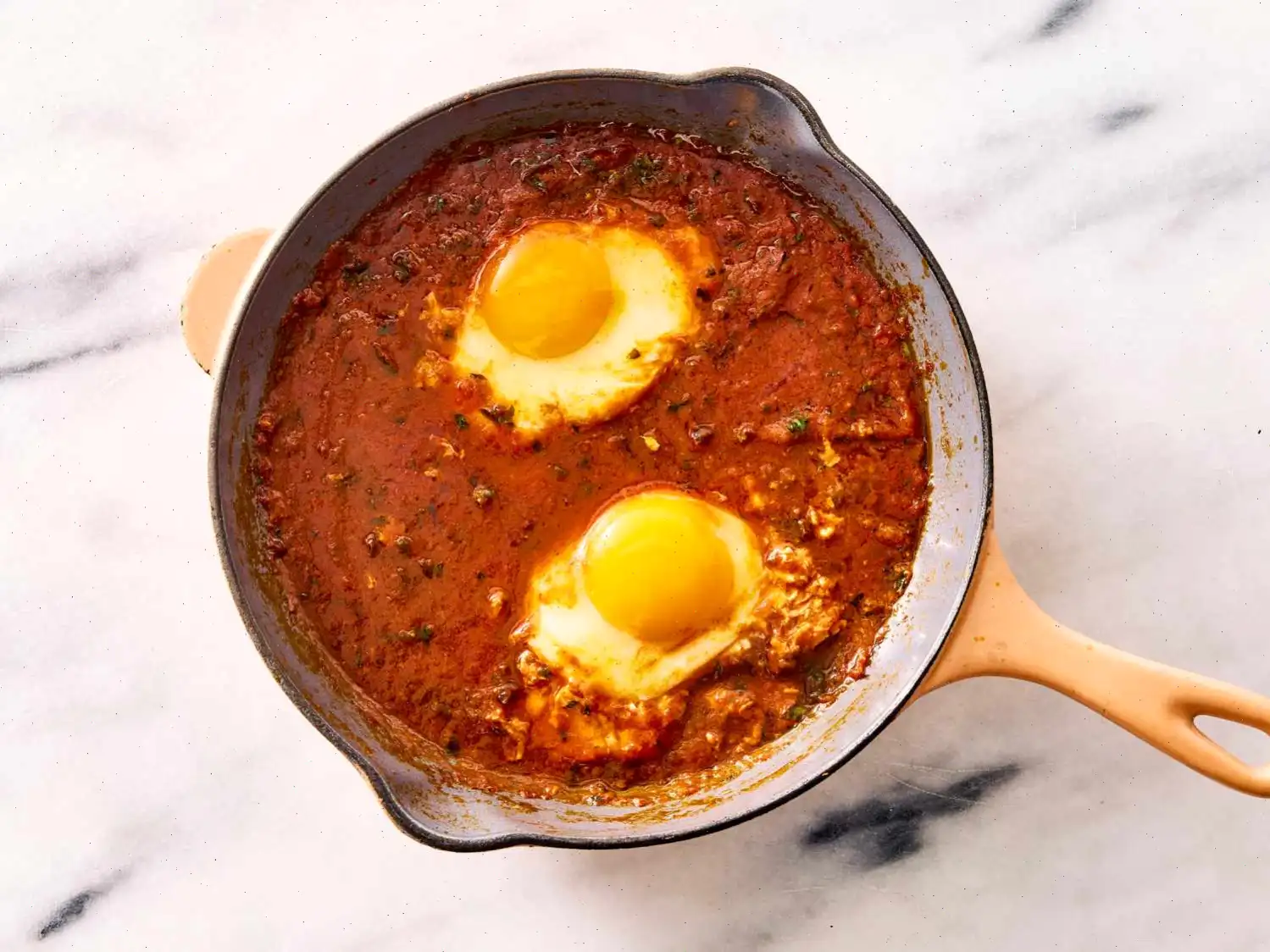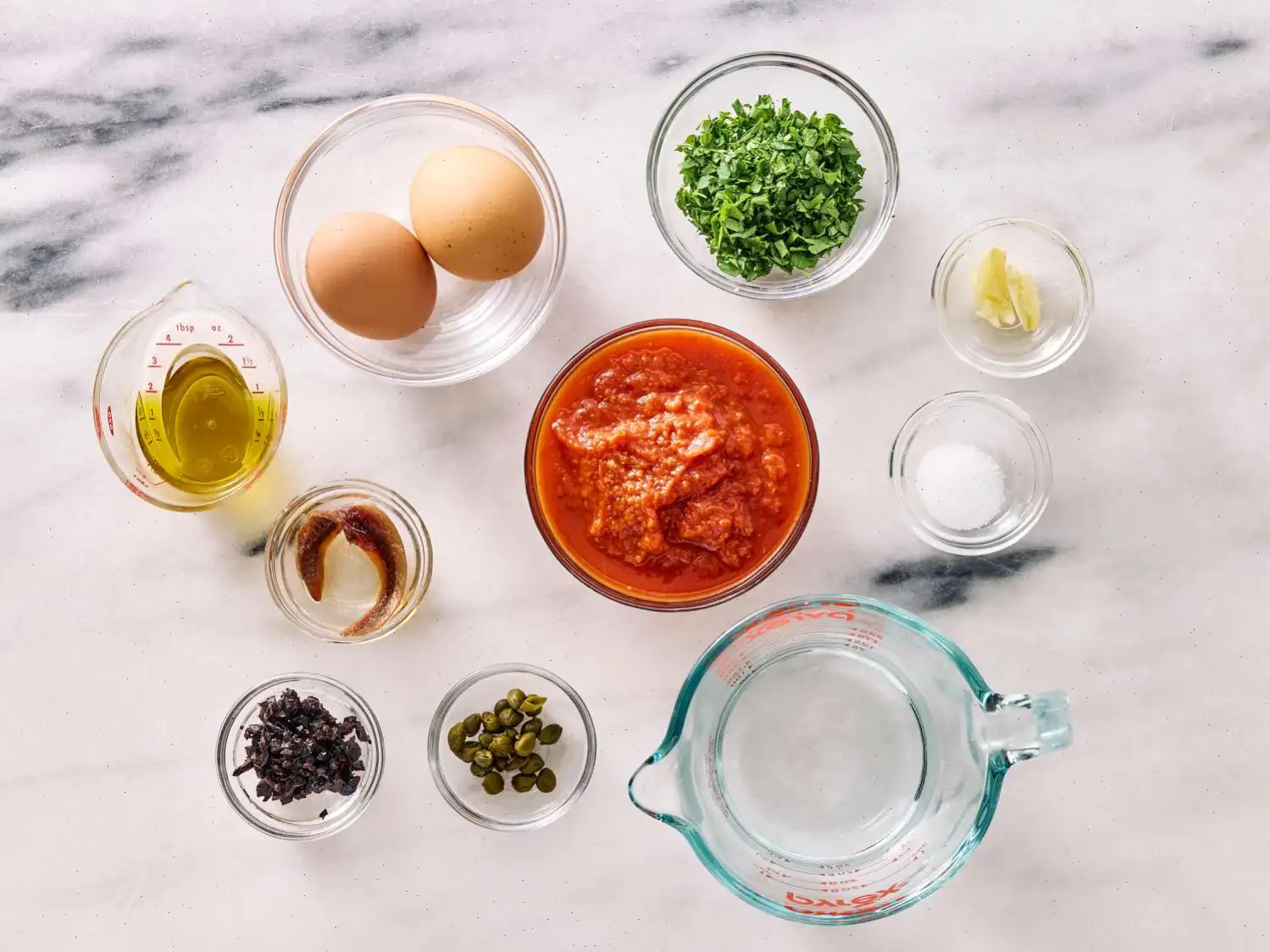
Eggs in Purgatory Recipe
Ingredients
This recipe was developed at its original yield. Ingredient amounts are automatically adjusted, but cooking times and steps remain unchanged. Note that not all recipes scale perfectly.
Original recipe (1X) yields 2 servings
- 2 tablespoons extra-virgin olive oil
- 1 clove garlic, crushed
- 3 black Italian olives, pitted and chopped, or more to taste
- 1 teaspoon capers
- 1 anchovy fillet in oil, drained
- 7 ounces Italian tomato sauce (crushed tomatoes)
- cup water
- 1 sprig chopped fresh parsley
- Salt to taste
- 2 large eggs
Directions
- Gather all the ingredients.
- Heat olive oil in a skillet over low heat.
- Add the crushed garlic, chopped olives, capers, and anchovy fillet to the skillet. Cook for 1-2 minutes until the mixture is fragrant.
- Pour in the tomato sauce and add water. Bring to a boil, then lower the heat and let it simmer for about 10 minutes, allowing the flavors to blend together.
- Stir in the chopped parsley and season with salt to taste.
- Carefully crack the eggs directly into the tomato sauce, making sure not to break the yolks.
- Cover and cook the eggs in the sauce for 3-5 minutes, or until the whites are set and the yolks are cooked to your liking.
Nutrition Facts (per serving)
| Nutrition | Amount | % Daily Value |
|---|---|---|
| Calories | 245 | 12% |
| Total Fat | 20g | 26% |
| Saturated Fat | 4g | 19% |
| Cholesterol | 188mg | 63% |
| Sodium | 470mg | 20% |
| Total Carbohydrate | 10g | 3% |
| Dietary Fiber | 3g | 10% |
| Total Sugars | 1g | |
| Protein | 9g | 18% |
| Vitamin C | 28mg | 31% |
| Calcium | 96mg | 7% |
| Iron | 4mg | 19% |
| Potassium | 454mg | 10% |

Eggs in Purgatory (or "Uova in Purgatorio" in Italian) is a traditional Italian dish that consists of eggs poached in a flavorful and spicy tomato sauce. It is a comforting, savory meal that combines the richness of eggs with the bold flavors of garlic, olives, capers, and anchovy. This dish is ideal for a hearty breakfast, brunch, or even a light dinner. The name itself, "in purgatory," refers to the idea that the eggs are caught in the fiery, spicy tomato sauce, creating a rich contrast between the heat of the sauce and the delicacy of the eggs.
Origin and History
The origin of "Eggs in Purgatory" can be traced to Southern Italy, particularly in regions such as Campania, where tomato-based dishes are a staple. The dish is thought to have been inspired by the rustic, peasant-style cooking of Italian farmers who would prepare simple, hearty meals with ingredients they had on hand. These meals often included eggs and locally sourced vegetables, like tomatoes and olives, which are abundant in the Mediterranean region. The dishs name, "in purgatory," likely refers to the simmering tomato sauce that envelops the eggs, a fiery metaphor for the "purgatory" before they are ready to eat.
Regional Variations
While "Eggs in Purgatory" is a beloved dish across Italy, there are slight regional variations. In southern Italy, especially in Naples, the sauce tends to be spicier, often incorporating chili peppers or other fiery seasonings. In other parts of the country, such as Tuscany, the dish may be made with a milder sauce, and the addition of ingredients like fresh basil or pancetta is more common. Each regions version of this dish highlights the local preferences for spiciness, richness, and the inclusion of seasonal ingredients.
How Does It Compare to Similar Dishes?
Eggs in Purgatory is often compared to other poached egg dishes like "Shakshuka," a North African and Middle Eastern recipe that features poached eggs in a spiced tomato and pepper sauce. While both dishes involve poached eggs in a savory sauce, Eggs in Purgatory tends to have a stronger Mediterranean influence with the inclusion of olives, capers, and anchovy, making it more tangy and briny compared to the sweeter, spicier flavor profile of Shakshuka. Another difference lies in the use of oilEggs in Purgatory often begins with extra-virgin olive oil, giving the sauce a distinct, fruity flavor that sets it apart from other similar dishes.
Where Is It Typically Served?
Eggs in Purgatory is commonly served in Italy for breakfast or brunch, although it can easily transition into a light dinner as well. In the southern regions of Italy, it is often served with a side of crusty bread, perfect for dipping into the rich, spicy tomato sauce. The dish is also popular in Mediterranean cafs and Italian restaurants worldwide, often offered as a rustic brunch option. Its especially beloved for its ability to be made in a single skillet, making it both delicious and easy to prepare, perfect for a quick and satisfying meal.
Interesting Facts
- The term "Purgatory" in the dishs name may refer to the fact that the eggs are poached in a "fiery" sauce, much like the cleansing flames of purgatory in Christian theology.
- In some variations of the dish, eggs are cracked directly into the sauce and cooked until just set, creating a rich combination of runny yolk and spicy tomato sauce.
- In Naples, where the dish is especially popular, the eggs are sometimes cooked with a sprinkle of grated Parmesan or pecorino cheese to enhance the dishs richness.
- Eggs in Purgatory is an excellent source of protein and vitamins, making it both a tasty and nutritious meal. The addition of tomatoes also provides a good dose of vitamin C and antioxidants.
Whether enjoyed as a weekend brunch or as a light evening meal, Eggs in Purgatory offers a comforting taste of Southern Italy, combining simple ingredients with bold flavors. Its popularity continues to grow beyond Italys borders, and it remains a perfect dish for those seeking a quick, delicious, and nutritious meal.
FAQ about Eggs in Purgatory Recipe
Comments
Chef Mo
10/06/2025 01:52:54 PM
I made this twice. First was in a pot but the eggs disappeared. Definitely use a skillet. I cut back the olive oil to about half. I would make it again with 4 eggs. Toast is a must. I broiled at the end for the tops to cook just a touch. Very fancy and rich in flavor!
Kimberly Gomez
06/22/2024 02:38:38 PM
So quick and incredibly delicious.
Ita
02/22/2024 02:14:47 PM
We really enjoyed this dish. I left out the olives - just a personal preference. Perfect for a weekend brunch or light dinner.
Roxy F
11/02/2021 03:54:40 AM
I loved this recipe and yes I needed bread I did add salt and pepper. Ty for sharing!












